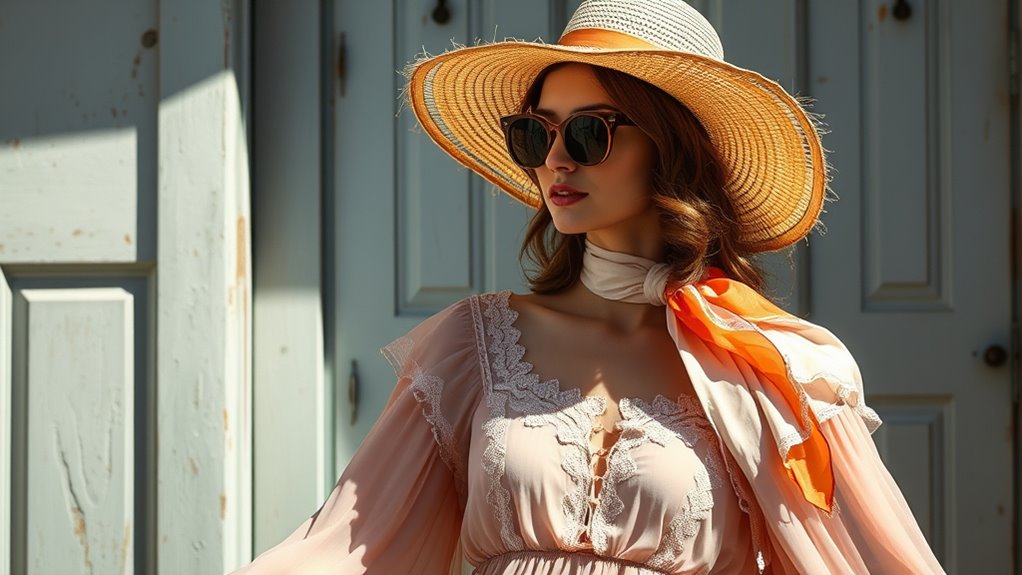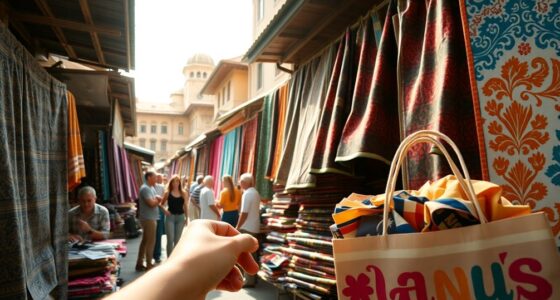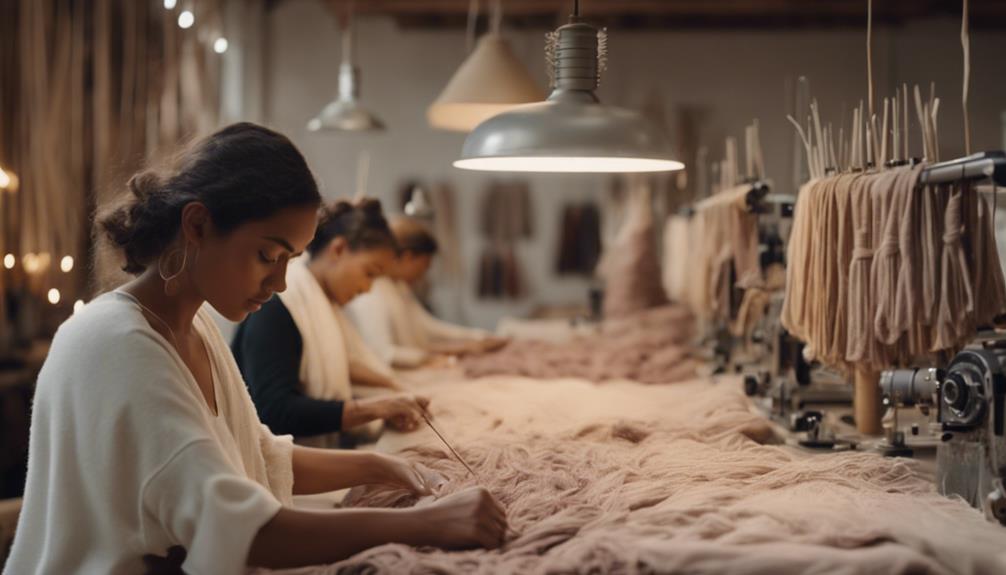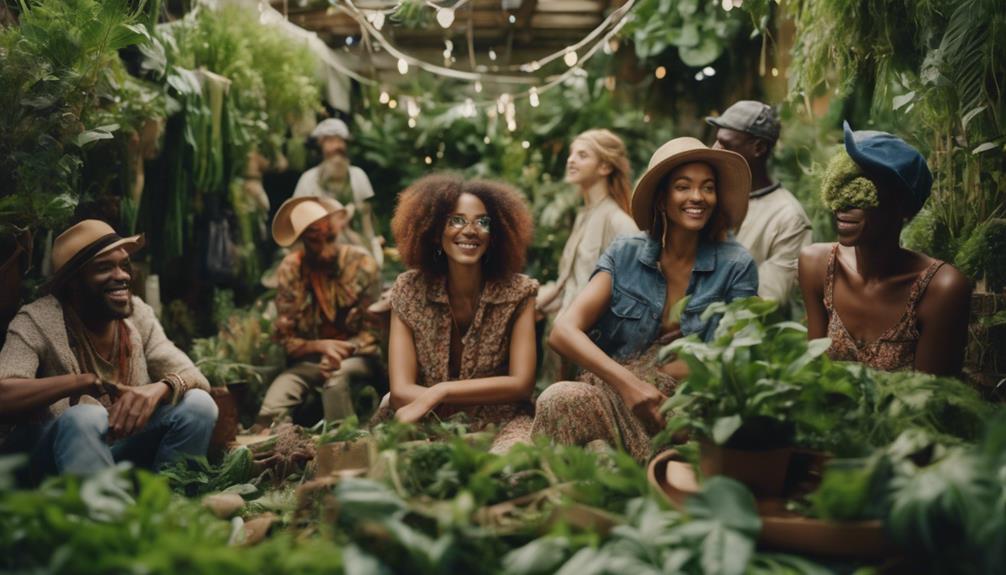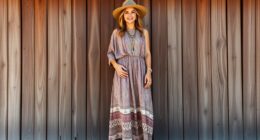The vintage fashion revival blends timeless styles with sustainability, allowing you to express individuality while reducing environmental impact. By choosing vintage pieces, you extend garment life, cut down on fast fashion waste, and support eco-friendly practices. Different eras offer unique looks, from the glamorous 1920s to bold 80s styles. Curating your wardrobe with authentic, quality vintage finds helps you embrace sustainable fashion. Explore further to discover how this movement is shaping a more conscious, stylish future.
Key Takeaways
- Vintage fashion offers eco-friendly benefits by reducing resource use and extending garment lifespan, supporting sustainable style.
- The revival emphasizes timeless designs and quality craftsmanship, promoting longevity over fleeting trends.
- Thrift stores and online marketplaces make authentic vintage pieces accessible, encouraging conscious shopping habits.
- Combining vintage with modern items allows personalized, versatile outfits while minimizing environmental impact.
- The cultural shift towards vintage promotes sustainable fashion practices, advocating reuse, recycling, and circular economy principles.
The Rise of Vintage Fashion in Contemporary Style
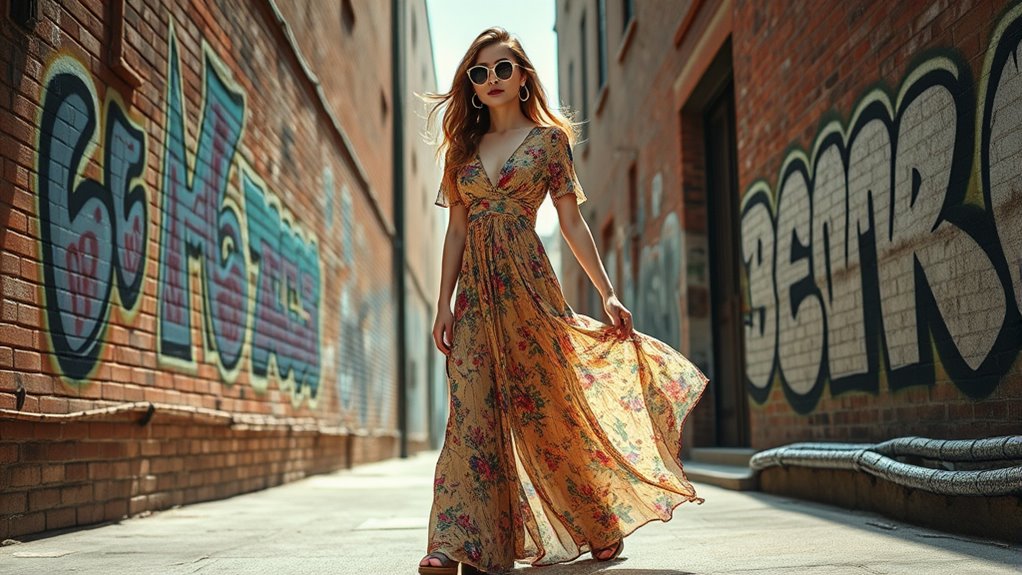
Despite the ever-changing trends in fashion, vintage styles have made a powerful comeback in recent years. You’ll notice more people embracing unique, timeless pieces that stand out from mass-produced clothing. Vintage fashion offers a sense of authenticity and individuality that modern fast fashion often lacks. Celebrities and influencers frequently showcase retro looks, fueling the trend’s popularity. Thrift stores and online marketplaces make it easier than ever to find quality vintage items, allowing you to curate a wardrobe filled with character and history. This resurgence isn’t just about nostalgia; it’s a conscious choice to prioritize style with substance. Additionally, sustainable fashion practices are gaining momentum, with many opting for recycled clothing to reduce environmental impact. As a result, vintage pieces now play a central role in contemporary fashion, blending past and present in fashion sustainability in fresh, exciting ways. Incorporating vintage textiles can further enhance the eco-friendly aspect of sustainable style. Moreover, understanding the cost and budgeting involved in sourcing vintage apparel can help enthusiasts make informed decisions while maintaining their style goals. Recognizing the importance of sound design in fashion showcases how audio elements can influence brand perception and consumer experience.
Eco-Friendly Benefits of Embracing Vintage Pieces
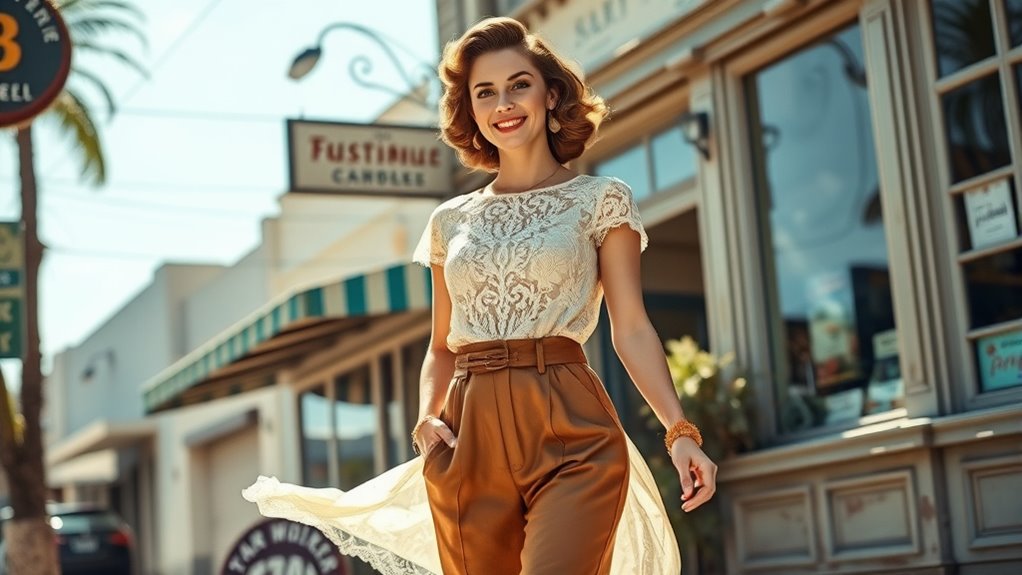
Choosing vintage pieces not only helps you stand out with unique style but also benefits the environment. When you select pre-loved clothing, you’re reducing demand for fast fashion, which often relies on resource-heavy production and generates significant waste. Vintage shopping extends the life of garments, preventing them from ending up in landfills. It also minimizes the need for new fabric manufacturing, conserving water, energy, and raw materials. By embracing vintage, you support sustainable consumption and contribute to a circular fashion economy. Many vintage items are made with higher-quality materials and craftsmanship, meaning they last longer and save you money over time. Additionally, understanding regulatory requirements for sustainable fashion can help consumers make more informed choices. Overall, your choice to wear vintage is a conscious step toward a more eco-friendly wardrobe. Vintage fashion offers a timeless appeal that transcends trends and supports environmental responsibility. Incorporating sustainable practices into your wardrobe choices amplifies the positive impact on the planet. Additionally, vintage clothing often features higher-quality materials, which enhances durability and extends lifespan.
Iconic Eras and Their Signature Looks
Throughout history, each era has defined its own distinctive style, making vintage fashion a treasure trove of iconic looks. From the flapper dresses of the 1920s to the bold power suits of the 1980s, you can find styles that capture the spirit of their time. The roaring twenties introduced beaded dresses, cloche hats, and bobbed hair, while the ’50s brought pencil skirts, poodle skirts, and saddle shoes. The psychedelic ’60s popularized colorful prints and miniskirts, and the ’70s embraced bohemian vibes with flowy dresses and fringe. Each era’s signature look reflects cultural shifts and societal values, giving you endless inspiration. By exploring these styles, you connect with history and add unique, timeless pieces to your wardrobe. Additionally, understanding the market interest in vintage fashion can inspire sustainable choices and appreciation for the craftsmanship of past eras. Recognizing the authenticity and historical significance of vintage pieces can deepen your appreciation and ensure genuine quality. Exploring the celebrity transformations associated with vintage styles can also inspire modern reinterpretations of classic looks. Incorporating natural elements in styling or decor can further enhance the nostalgic and authentic feel of vintage looks. Staying informed about current cultural trends can also help you blend vintage pieces seamlessly into modern fashion.
How to Curate a Unique Vintage Wardrobe
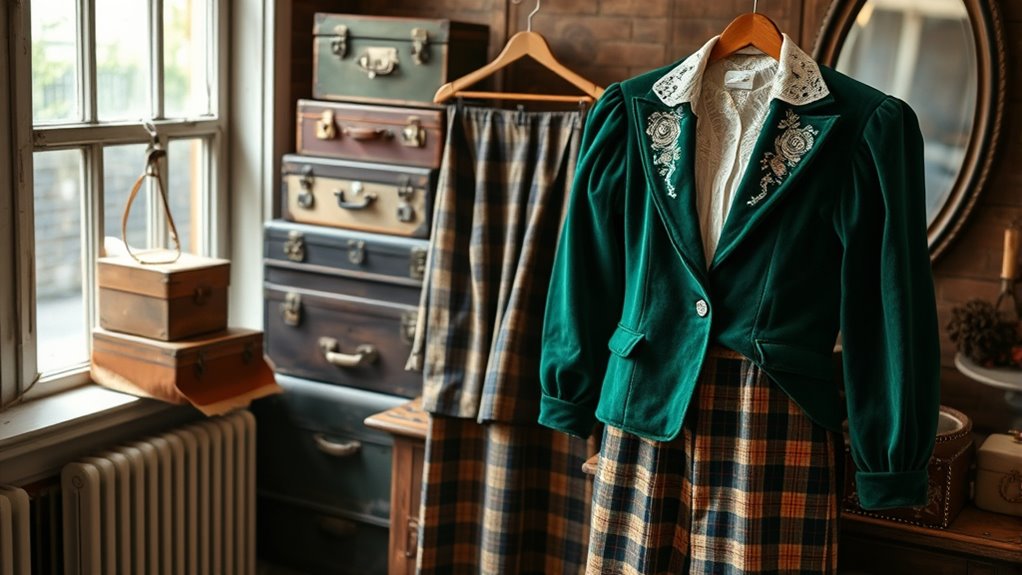
Ever wondered how to build a vintage wardrobe that truly reflects your personal style? Start by identifying the eras and looks that resonate with you. Focus on quality pieces over quantity to guarantee longevity. Mix and match items to create versatile outfits, blending vintage with modern for a fresh twist. Look for key staples like statement accessories, timeless outerwear, and classic fabrics. Keep an eye out for:
- Unique, well-preserved pieces that stand out
- Versatile items that can be styled multiple ways
- Authentic vintage accessories to add flair
- Quality over quantity, prioritizing durability
Building a curated vintage wardrobe is about expressing your individuality. Be patient, enjoy exploring thrift stores and online marketplaces, and trust your instincts. Incorporating color accuracy into your vintage pieces can help ensure that your outfits look true to their original style and vibrancy. Additionally, understanding IRA investment strategies can inspire you to diversify your wardrobe investments wisely, ensuring both style and longevity. Developing an eye for authenticity can also help you distinguish genuine vintage items from reproductions, enhancing your collection’s value and uniqueness. Being aware of narcissistic abuse and its effects can also help you cultivate a wardrobe that empowers your confidence and personal expression. Your style should be a reflection of who you are.
The Future of Sustainable Fashion and Vintage Trends
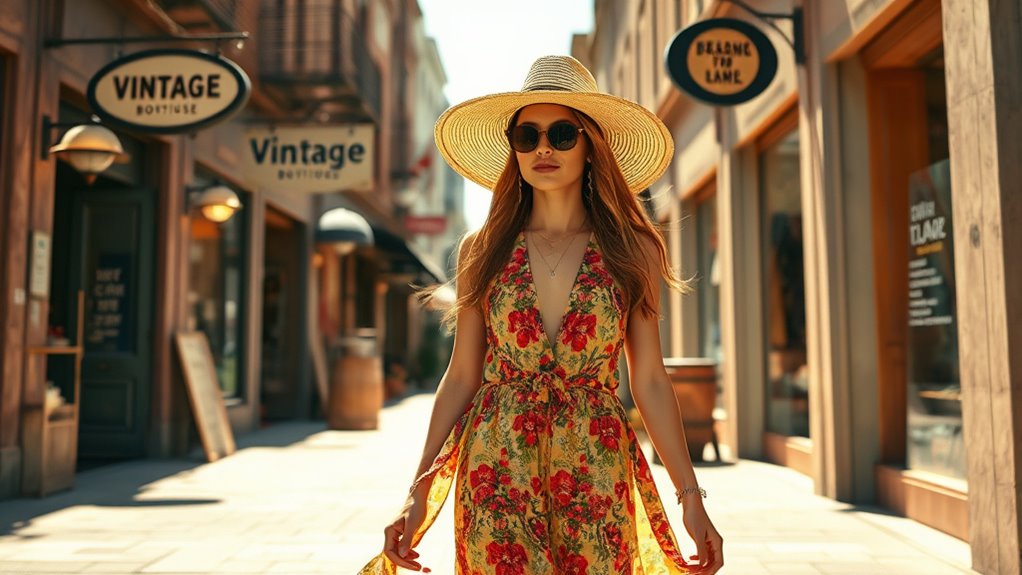
As vintage fashion continues to capture interest, its role in shaping sustainable trends grows more significant. You’re likely to see brands increasingly prioritize upcycling and repurposing, blending retro styles with modern sustainability goals. Technology will play a key role, making vintage pieces more accessible through online marketplaces and virtual try-ons. Consumers like you will demand transparency about sourcing and eco-friendly practices, pushing the industry toward greener standards. Vintage-inspired designs will also evolve, focusing on longevity and timeless appeal rather than fleeting trends. As you embrace this future, you’ll contribute to reducing waste and supporting circular fashion. Additionally, ethical hacking practices are becoming a core part of the vintage fashion movement, encouraging environmentally conscious choices. The influence of impactful quotes can inspire both consumers and designers to prioritize sustainability in their fashion choices, fostering a deeper connection to ethical practices. Moreover, incorporating sustainable materials into vintage designs enhances their environmental benefits and durability. Recognizing the importance of mind-body connection in sustainable practices can deepen your appreciation for crafting and wearing clothing intentionally. Overall, vintage fashion’s revival isn’t just about style — it’s shaping a more sustainable, conscious approach to how you shop and wear clothing.
Frequently Asked Questions
How Can I Identify Authentic Vintage Clothing From Replicas?
When trying to tell authentic vintage clothing apart from replicas, start by examining the fabric and construction. Authentic vintage pieces often show signs of age, like fading or wear, and are made with quality materials. Check labels for era-specific tags or brand markings, and research the item’s style and details. Trust your intuition and inspect stitching, buttons, and seams closely—these clues help confirm if it’s genuinely vintage.
What Are the Best Places to Find High-Quality Vintage Pieces?
You want to find high-quality vintage pieces, so start by exploring reputable thrift stores, vintage boutiques, and online marketplaces like Etsy or Depop. Look for shops with good reviews and detailed descriptions. Attend vintage fairs or estate sales for unique finds. Trust your eye for quality—examine fabrics, stitching, and labels. By shopping at trusted sources, you increase your chances of discovering authentic, well-maintained vintage fashion.
How Do Vintage Styles Influence Modern Fashion Trends?
You might be surprised how vintage styles influence modern fashion trends, often through unexpected coincidences. When you spot a retro-inspired piece on the runway or in a street style photo, it’s usually a nod to past decades. These influences shape current designs, making them fresh yet nostalgic. By embracing vintage elements, you help create a sustainable, stylish future, blending history with contemporary trends effortlessly.
Are There Specific Care Tips for Maintaining Vintage Garments?
You should handle vintage garments gently to preserve their quality. Always read care labels and opt for hand washing or dry cleaning when recommended. Use mild detergents and avoid bleach. Store items in a cool, dry place, preferably hanging or folded with acid-free tissue. Limit exposure to direct sunlight to prevent fading. Regularly inspect and repair any damage to keep your vintage pieces looking their best.
Can Vintage Fashion Be Adapted for Everyday Wear?
You can definitely adapt vintage fashion for everyday wear by choosing versatile, timeless pieces that suit your style. Mix vintage items with modern basics to keep your look fresh and practical. Pay attention to fit and comfort, and consider minor alterations if needed. Incorporate vintage accessories to add unique touches. With thoughtful styling, you’ll create a sustainable, stylish wardrobe that stands out daily without feeling out of place.
Conclusion
As you weave vintage pieces into your wardrobe, you’re planting seeds of sustainability that bloom into timeless style. Each garment becomes a symbol of respect for the past and hope for the future, reminding you that fashion can be both beautiful and responsible. Embrace the journey of discovery, where every vintage find is a piece of history waiting to inspire. Your wardrobe isn’t just a collection—it’s a living legacy of mindful, sustainable fashion.
